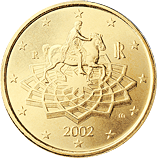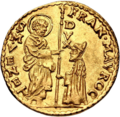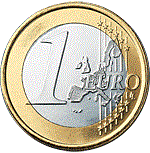
There are eight euro coin denominations, ranging from one cent to two euros. The coins first came into use in 2002. They have a common reverse, portraying a map of Europe, but each country in the eurozone has its own design on the obverse, which means that each coin has a variety of different designs in circulation at once. Four European microstates that are not members of the European Union use the euro as their currency and also have the right to mint coins with their own designs on the obverse side.
Greek euro coins feature a unique design for each of the eight coins. They were all designed by Georgios Stamatopoulos with the minor coins depicting Greek ships, the middle ones portraying famous Greeks and the two large denominations showing images of Greek history and mythology. All designs feature the 12 stars of the EU, the year of imprint and a tiny symbol of the Bank of Greece. Uniquely, the value of the coins is expressed on the national side in the Greek alphabet, as well as being on the common side in the Roman alphabet. The euro cent is known as the lepto in Greek, a name which has also been used for the 1⁄100 denominations of the preceding currencies of the Greek state, the phoenix and drachma.
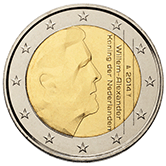
Dutch euro coins currently use two designs by Erwin Olaf, both of which feature a portrait of King Willem-Alexander of the Netherlands. The new designs began circulating in 2014. Dutch Euro coins minted from 1999 to 2013 feature a portrait of Queen Beatrix designed by Bruno Ninaber van Eyben. All coins share the 12 stars of the EU and the year of imprint in their design.

French euro coins feature three separate designs for the three series of coins. The minor series was designed by Fabienne Courtiade, the middle one by Laurent Jurio and the major two coins are by Joaquin Jimenez. All designs share the 12 stars of the EU and the year of imprint as well as the letters "RF" for République Française.
Portuguese euro coins show three different designs for each of the three series of coins. However, they are quite similar in that all contain old Portuguese royal mints and seals within a circle of seven castles and five escutcheons with silver bezants and the word "Portugal". Also featured in the designs, all done by Vítor Manuel Fernandes dos Santos, are the 12 stars of the EU and the year of minting.
Austrian euro coins have a unique design for each denomination, with a common theme for each of the three series of coins. The minor coins feature Austrian flowers, the middle coins examples of architecture from Austria's capital, Vienna, and the two major coins famous Austrians. All designs are by the hand of Josef Kaiser and also include the 12 stars of the EU, Flag of Austria and the year of imprint.

Carlo Azeglio Ciampi was an Italian politician and banker who was the prime minister of Italy from 1993 to 1994 and the president of Italy from 1999 to 2006.
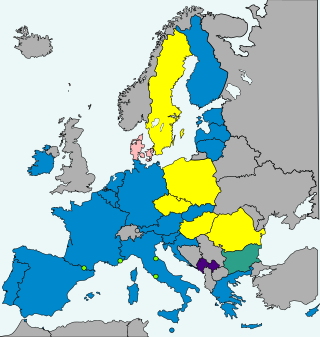
Vatican euro coins are issued by the Philatelic and Numismatic Office of the Vatican City State and minted by Istituto Poligrafico e Zecca dello Stato (IPZS), in Rome, Italy. The euro is the official currency of the Vatican City, although Vatican City is not a member of the Eurozone or the European Union. The euro has been the official currency of Vatican City since 2002. Before that, the Vatican lira was the official currency.
There have been three sets of coins in Ireland since independence. In all three, the coin showed a Celtic harp on the obverse. The pre-decimal coins of the Irish pound had realistic animals on the reverse; the decimal coins retained some of these but featured ornamental birds on the lower denominations; and the euro coins used the common design of the euro currencies. The pre-decimal and original decimal coins were of the same dimensions as the same-denomination British coins, as the Irish pound was in currency union with the British pound sterling. British coins were widely accepted in Ireland, and conversely to a lesser extent. In 1979 Ireland joined the Exchange Rate Mechanism and the Irish pound left parity with sterling; coin designs introduced after this differed between the two countries.
Slovenian euro coins were first issued for circulation on 1 January 2007 and a unique feature is designed for each coin. The design of approximately 230 million Slovenian euro coins was unveiled on 7 October 2005. The designers were Miljenko Licul, Maja Licul and Janez Boljka. The Mint of Finland was chosen to mint the coins through an international tender in 2007.
Cypriot euro coins feature three separate designs for the three series of coins. Cyprus has been a member of the European Union since 1 May 2004, and is a member of the Economic and Monetary Union of the European Union. It has completed the third stage of the EMU and adopted the euro as its official currency on 1 January 2008.
Maltese euro coins feature three separate designs for the three series of coins. Malta has been a member of the European Union since 1 May 2004, and is a member of the Economic and Monetary Union of the European Union. Malta adopted the euro as its official currency on 1 January 2008, replacing the Maltese lira. For a period of one month until 31 January, there was a dual circulation for Malta where the Euro and Maltese lira were used alongside each other.

The 1 euro cent coin (€0.01) has a value of one hundredth of a euro and is composed of copper-covered steel. It is the lowest-value coin in the Eurozone; the next highest are the 2 and 5 euro cent coins. All euro coins have a common reverse and a country-specific (national) obverse. The coin has been used since 2002 and was not redesigned in 2007 as was the case with the higher-value coins.

The 2 euro cent coin (€0.02) has a value of one-fiftieth of a euro and is composed of copper-plated steel. All euro coins have a common reverse and country-specific (national) obverse. The coin has been used since 2002 and was not redesigned in 2007 as were the higher-value coins.

The 5 euro cent coin (€0.05) has a value of one twentieth of a euro and is composed of copper-covered steel. All euro coins have a common reverse and country-specific (national) obverse. The coin has been used since 2002 and was not re-designed in 2007 as was the case with the higher-value coins.

The 10 euro cent coin (€0.10) has a value of one tenth of a euro and is composed of an alloy called Nordic gold. All euro coins have a common reverse side and country-specific national sides. The coin has been used since 2002, with the present common side design dating from 2007.

The 50 euro cent coin (€0.50) has a value of half a euro and is composed of an alloy called nordic gold. All euro coins have a common reverse side and country-specific national sides. The coin has been used since 2002, with the present common-side design dating from 2007.

The 1 euro coin (€1) is a euro coin with a value of one euro. It is made of two alloys: the inner part of cupronickel, the outer part of nickel brass. All coins have a common reverse side and country-specific national sides. The coin has been used since 2002, with the present common side design dating from 2007.
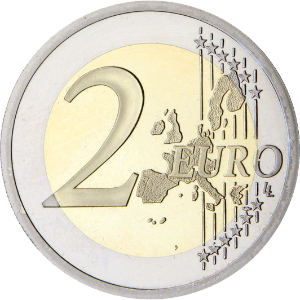
The 2 euro coin (€2) is the highest-value euro coin and has been used since the introduction of the euro in 2002. The coin is used in 22 countries with a collective population of about 341 million. The coin is made of two alloys: the inner part of nickel brass, the outer part of copper-nickel. All coins have a common reverse side and country-specific national sides. The coin has been used since 2002, with the present common side design dating from 2007.

Italy has a long history of different coinage types, which spans thousands of years. Italy has been influential at a coinage point of view: the medieval Florentine florin, one of the most used coinage types in European history and one of the most important coins in Western history, was struck in Florence in the 13th century, while the Venetian sequin, minted from 1284 to 1797, was the most prestigious gold coin in circulation in the commercial centers of the Mediterranean Sea.



